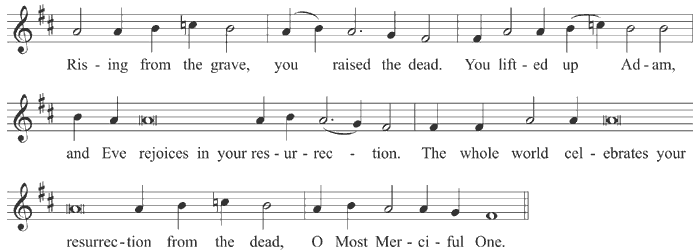The Tone 8 Kontakion Melody
This prostopinije melody is one of four special feast-day melodies (in Tones 3, 4, 6, and 8) which are now used for singing all kontakia in these four tones. This page explains how to sing the tone 4 kontakion melody.
The kontakion of Pascha
Each of the four kontakion melodies is derived from the melody of the kontakion for an important feast. In Tone 8, this is the kontakion of Pascha, the feast of the Resurrection of the Lord:
Here is the Sunday kontakion in Tone 8:
Each phrase begins on mi or sol, giving the entire melody the vibrancy of a trumpet call.
The Structure of the Melody
The tone 8 kontakion melody consists of two alternating melodic phrases:
an A phrase
and a B phrase
The tone 8 kontakion melody always ends with the B phrase:
A - B - A - B - A - B
The A phrase
The A phrase melody consists of an intonation, a reciting tone, and a cadence with two preparatory notes:
The intonation of the A phrase is used to sing the notes that come before the first text accent. If the text phrase begins with an accent, then the intonation may be omitted entirely.
Text is then sung on the reciting tone (so), using free speech rhythm, until one of two syllables before the cadence.
The cadence is used to sing the final accent of the text, and any unaccented syllables that follow it:
To signal the approach of the cadence, two preparatory notes are used. They are used to sing the two syllables before the cadence - or slurred together to sing the syllable immediately before the cadence, if it is accented:
The two preparatory notes may also be slurred together if the text phrase is very short:
The B phrase
The A phrase melody consists of an intonation, a reciting tone, and a cadence with a single preparatory note:
The intonation of the B phrase is used to sing one or two syllables before the first internal text accent. If there are three or more syllables before this accent, then the intonation is used to sing a single syllable, and the first syllable on the reciting tone is not accented. Be careful not to sing the first reciting tone note too strongly in this case.
Text is then sung on the reciting tone (sol), using free speech rhythm, until the syllable before the cadence.
The cadence can be used to sing two, three or four syllables:
To signal the approach of the cadence, a preparatory note is used to sing the syllable before the cadence. The preparatory note is melodically weak; if the syllable before the cadence is accented, we slur to reciting tone and the preparatory note together.
The reciting tone and preparatory note may also be slurred together if the text phrase is exceptionally short
In this example, the intonation is absent as well.
Melodies for Glory / Now and ever
Here is how "Glory... Now and ever...." should be sung before a kontakion in tone 8:
Here is how "Glory...." and "Now and ever...." should be sung when one or the other is sung before a kontakion in tone 8:
Other uses of the melody
The Tone 8 kontakion melody is used to sing Psalm 112 at the funeral service for a child; it is sometimes used to sing other psalms as well.
Learning the melody
- Sing through the examples of tone 8 kontakia, all of which use this melody. Of these, the Kontakion of Pascha is particularly important.
- Memorize the Glory, Now and ever melodies (above) and practice singing them from memory, immediately followed by kontakia in tone 8.




















